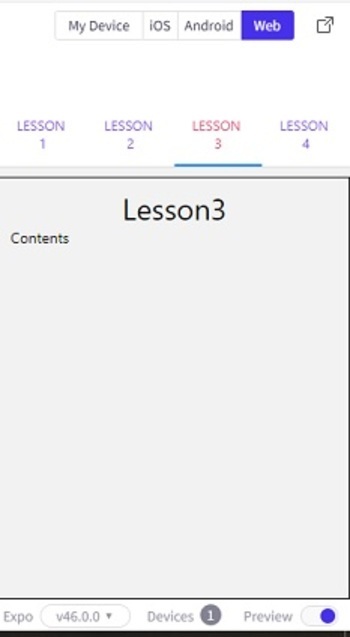在Snack中使用选项卡
选项卡是用于在应用中实现多页面视图的。选项卡通常位于屏幕的顶部或底部。一些库允许在移动应用中创建选项卡。选项卡也可以使用简单的组件(如按钮)来创建。本文将展示使用React Native和JavaScript代码的两个不同示例,其中第一个示例使用按钮来创建选项卡。在另一个示例中,使用’@react-navigation/material-top-tabs’中的createMaterialTopTabNavigator来创建选项卡,然后将这些选项卡渲染到设备的屏幕上。
步骤1
步骤1 - 从’react-native’导入Text、View、StyleSheet和Button。
步骤2 -编写独立的函数,显示不同页面的内容。
步骤3 - 创建App.js并编写代码。创建四个按钮,并将其放置为顶部选项卡。
步骤4 - 创建指定选项卡的页面内容,并通过按钮点击显示。
步骤5 - 创建一个新的样式,并将其命名为selectedOne。当选择给定的选项卡时,设置此样式。这将使指定的选项卡与该行中的其他非选定选项卡看起来不同。
步骤6 - 检查结果。
示例1:在Snack上使用按钮创建选项卡
该项目中使用的重要文件为
- App.js
App.js:这是该项目的主要javascript文件。
示例
import{Component}from'react';
import{Text,View,StyleSheet,Button}from'react-native';
exportdefaultclassAppextendsComponent{
constructor(props){
super(props);
this.state={
LessonSelected:'One',
btnClr:"#6690ad",
};
}
render(){
return(
<Viewstyle={styles.mainSpace}>
<Viewstyle={styles.Lessonbuttons}>
<Viewstyle={this.state.LessonSelected==='One'?styles.selectedOne:null}>
<Button
onPress={()=>{
this.setState({LessonSelected:'One'});
}}
title="Lesson1"
color={this.state.btnClr}
borderColor='#000'
/>
</View>
<Viewstyle={this.state.LessonSelected==='Two'?styles.selectedOne:null}>
<Button
onPress={()=>{
this.setState({LessonSelected:'Two'});
}}
title="Lesson2"
color={this.state.btnClr}
/>
</View>
<Viewstyle={this.state.LessonSelected==='Three'?styles.selectedOne:null}>
<Button
onPress={()=>{
this.setState({LessonSelected:'Three'});
}}
title="Lesson3"
color={this.state.btnClr}
/>
</View>
<Viewstyle={this.state.LessonSelected==='Four'?styles.selectedOne:null}>
<Button
onPress={()=>{
this.setState({LessonSelected:'Four'});
}}
title="Lesson4"
color={this.state.btnClr}
/>
</View>
</View>
{this.state.LessonSelected==='One'?this.showLesson1()
:this.state.LessonSelected==='Two'?this.showLesson2()
:this.state.LessonSelected==='Three'?this.showLesson3()
:this.state.LessonSelected==='Four'?this.showLesson4()
:this.showLesson1()
}
</View>
);
}
showLesson1=()=>(
<Viewstyle={[styles.Lessoncontents,styles.Lessons]}>
<Textstyle={styles.LessonHeader}>Lesson1</Text>
<Textstyle={styles.LessonContent}>Contents</Text>
</View>
);
showLesson2=()=>(
<Viewstyle={[styles.Lessoncontents,styles.Lessons]}>
<Textstyle={styles.LessonHeader}>Lesson2</Text>
<Textstyle={styles.LessonContent}>Contents</Text>
</View>
);
showLesson3=()=>(
<Viewstyle={[styles.Lessoncontents,styles.Lessons]}>
<Textstyle={styles.LessonHeader}>Lesson3</Text>
<Textstyle={styles.LessonContent}>Contents</Text>
</View>
);
showLesson4=()=>(
<Viewstyle={[styles.Lessoncontents,styles.Lessons]}>
<Textstyle={styles.LessonHeader}>Lesson4</Text>
<Textstyle={styles.LessonContent}>Contents</Text>
</View>
);
}
conststyles=StyleSheet.create({
mainSpace:{
flex:1,
marginTop:50,
},
Lessonbuttons:{
width:'100%',
flexDirection:'row',
justifyContent:'space-between',
},
Lessoncontents:{
flex:1,
width:'100%',
padding:10,
marginTop:10,
borderWidth:1,
borderColor:'black',
},
LessonHeader:{
color:'black',
fontSize:28,
textAlign:'center',
},
selectedOne:{
borderBottomWidth:10,
borderBottomColor:'#ffc181',
},
});
结果
尽管结果可以在线上查看,但是在这里展示的是个人移动设备上的显示效果。

步骤2
步骤1 - 从’react-native’导入Text,View,StyleSheet。
步骤2 - 从’@react-navigation/native’导入NavigationContainer,然后从’@react-navigation/material-top-tabs’导入createMaterialTopTabNavigator。
步骤3 - 编写显示不同页面内容的单独函数。
步骤4 - 创建App.js并编写代码。使用createMaterialTopTabNavigator()创建一个LessonTab。
步骤5 - 创建NavigationContainer标签,并在其中创建LessonTab.Navigator。在不同的LessonTab.Screen中调用页面内容函数。
步骤6 - 检查结果
示例2:使用’@react-navigation/material-top-tabs’创建选项卡
该项目中使用的重要文件是
- App.js
App.js:这是该项目的主要JavaScript文件。
示例
import {Component} from 'react';
import { Text, View, StyleSheet } from 'react-native';
import { NavigationContainer } from '@react-navigation/native';
import { createMaterialTopTabNavigator } from '@react-navigation/material-top-tabs';
const LessonTab = createMaterialTopTabNavigator();
export default class TopTabs extends Component {
constructor(props) {
super(props);
this.state = {
LessonSelected: 'One',
btnClr: "#6690ad",
};
}
render(){
return (
<View style={styles.mainSpace}>
<NavigationContainer>
<LessonTab.Navigator
tabBarOptions={{
activeTintColor: '#e3486a',
inactiveTintColor: '#7448e3',
}}
>
<LessonTab.Screen name="Lesson 1" component={this.showLesson1} />
<LessonTab.Screen name="Lesson 2" component={this.showLesson2} />
<LessonTab.Screen name="Lesson 3" component={this.showLesson3} />
<LessonTab.Screen name="Lesson 4" component={this.showLesson4} />
</LessonTab.Navigator>
</NavigationContainer>
</View>
);
}
showLesson1 = () => (
<View style={[styles.Lessoncontents, styles.Lessons]}>
<Text style={styles.LessonHeader}>Lesson1</Text>
<Text style={styles.LessonContent}>Contents</Text>
</View>
);
showLesson2 = () => (
<View style={[styles.Lessoncontents, styles.Lessons]}>
<Text style={styles.LessonHeader}>Lesson2</Text>
<Text style={styles.LessonContent}>Contents</Text>
</View>
);
showLesson3 = () => (
<View style={[styles.Lessoncontents, styles.Lessons]}>
<Text style={styles.LessonHeader}>Lesson3</Text>
<Text style={styles.LessonContent}>Contents</Text>
</View>
);
showLesson4 = () => (
<View style={[styles.Lessoncontents, styles.Lessons]}>
<Text style={styles.LessonHeader}>Lesson 4 </Text>
<Text style={styles.LessonContent}>Contents</Text>
</View>
);
}
const styles = StyleSheet.create({
mainSpace: {
flex: 1,
marginTop: 50,
},
Lessoncontents: {
flex: 1,
width: '100%',
padding: 10,
marginTop: 10,
borderWidth: 1,
borderColor: 'black',
},
LessonHeader: {
color: 'black',
fontSize: 28,
textAlign: 'center',
},
});
输出
结果可以在线上查看。当用户输入代码时,默认选择Web视图,结果即时显示。

在本文中,使用两个不同的示例介绍了在Expo Snack上制作顶部选项卡的方法。 首先介绍了使用简单按钮制作选项卡的方法,然后介绍了使用 createMaterialTopTabNavigator from ‘@react-navigation/material-top-tabs’ 制作顶部选项卡的方法,并展示了在在线Web视图和个人移动设备上的输出。
 极客笔记
极客笔记